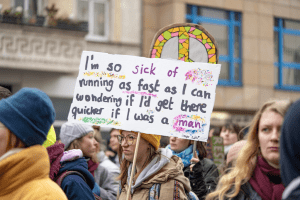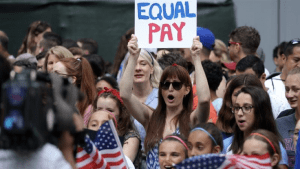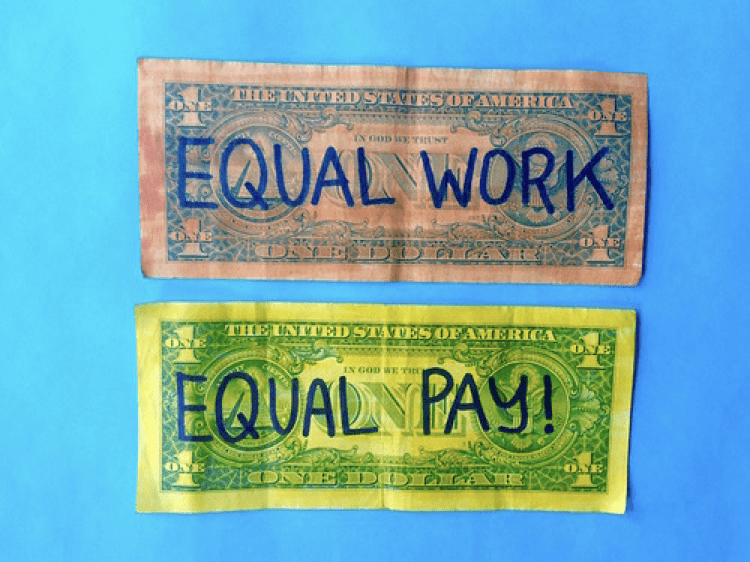by Lauren Lockhart, UAB student

I will never forget the time in my 12th-grade year that a boy told me the gender wage gap didn’t exist. Even after being presented with evidence and facts, he still swore that there is no pay gap based on gender, and if there were, it was obviously for a reason. Although this wasn’t the first time I had heard a statement like this regarding human rights and equality, I still cannot believe the pay inequality that exists based on gender, and how this gap continues to grow for individuals with compounding intersectional identities.
The Pay Gap During COVID-19
According to the U.S. Census, between 2018 and 2019, no progress has been made on closing the overall gender pay gap, with the average full-time working woman earning only 82 cents for every dollar earned by men. During COVID-19, this pay gap has continued to grow as women face more hardships and barriers as they try to support themselves and their families.
At the beginning of 2020, women’s labor force participation in the U.S. stood at 58%, but by October, it had dropped two percentage points because of COVID. Not only is this due to the fields that have been shut down were majority women, such as restaurants, tourism, and office space maintenance, but women have also had to shoulder the responsibility of childcare. Not only was this already a problem contributing to the pay gap before COVID, but it has since grown into a greater responsibility with the shutdown of daycare centers, schools, and after-school programs. This has led to many mothers having to reduce their hours or leave their jobs entirely to take care of their children. Among parents working at home during the crisis, fathers’ childcare has increased by 4.7 hours per day, while mothers’ hours of childcare has increased by 6.1 hours.
This reduction of hours for childcare has also increased the worry among women in the long-term evaluation for promotions and raises. Not being considered for raises and promotions puts working women during COVID at an even greater disadvantage due to the pay cuts they experienced at the beginning of the pandemic. A recent survey of 984 professionals showed that while men and women have experienced pandemic pay cuts at nearly equal rates, men (52%) were more likely than women (44%) to say their pay has been restored. So, these women are not only facing long-term consequences for their reduction in hours, but they are also facing issues presently with pay cuts and restoration.

On top of childcare and the fear of demotion, women who contract COVID face even greater obstacles. Experts and health professionals have started to call women that face COVID “long-haulers” because of the continued work and hardships that women face returning to the workforce after having the virus. After getting COVID, many women still wrestle with lingering symptoms, in addition to trying to balance home life and work. This creates numerous barriers for women amidst this strange time we are living in, with no long-term guarantees.
Women’s Well-Being in Alabama
The Women’s Fund of Greater Birmingham recently released its annual report, Status of Women, and although Alabama already treks behind many states in terms of gender equality, conditions for women have worsened amidst COVID-19. One of the key findings included in this report is that the wage gap in Alabama is wider than most other states and the national average, with women earning 73 cents for every dollar a man makes, compared to 82 cents for U.S. women overall. For women in Alabama who have children, the annual cost for an infant (under 12 months old) is nearly 17% of the mother’s median annual earnings, totaling approximately $5,858. However, add in that women have accounted for 57.3% of the total unemployment claims in Alabama since the beginning of COVID, and it seems that all of these factors can make it virtually impossible for women to sufficiently support themselves and their family.

Universal Fight for Gender Equality
Even though it may not be taking place in Alabama, six mayors around the world have joined forces with the organizers of City Hub and Network for Gender Equity (CHANGE) to fight the increased gender inequality during COVID-19. The network aims to continue to spread these projects among other city mayors in hopes of attracting more attention and progress. Los Angeles mayor, Eric Garcetti is requiring that every city department must have a gender action plan and measure to show progress on tackling gender equality. These measures can range from closing the gender pay gap, appointing women to boards and top positions, and ensuring more girls use public spaces, like sports fields. While these may not be large steps towards gender equality, there is an effort, nonetheless.

